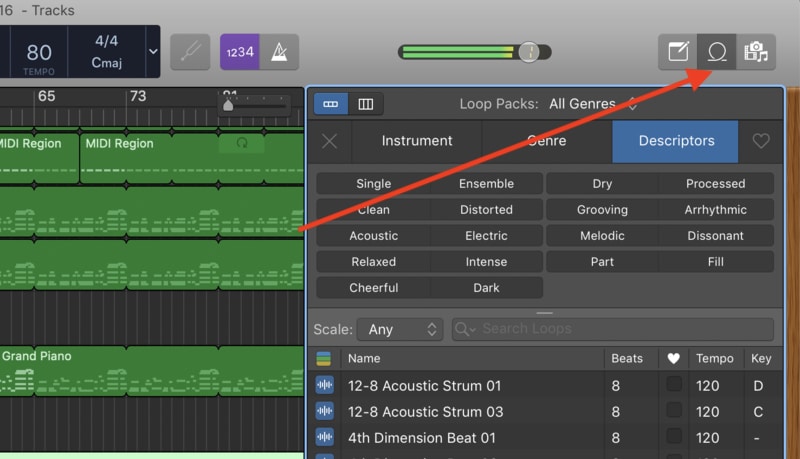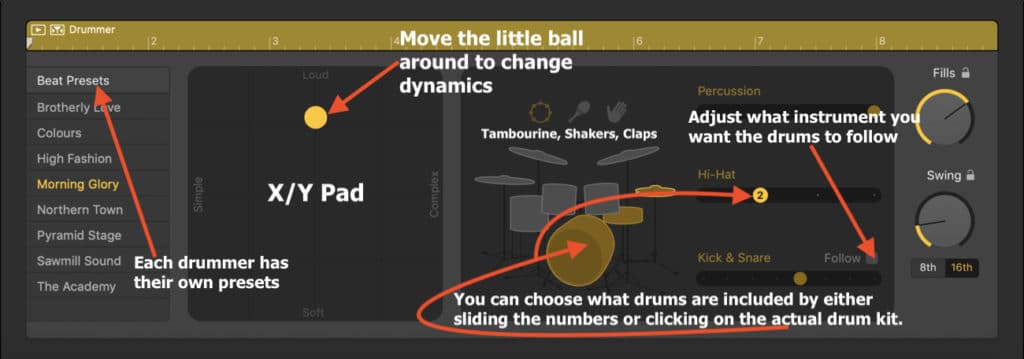1) Choose an Apple Loop from Garageband’s massive loop library.
2) Load up the drummer track of your choosing, and switch the drum kit to a hip-hop drum kit, such as the Trap Kit.
3) Load a sample of your choice into the workspace to fill out the track (optional)
Making Songs Without Using Instruments
1) Choose an Apple Loop from Garageband’s massive loop library.
As I laid out in my article on using Apple Loops, Garageband includes a massive loop library where each loop is categorized in a number of different ways, including by genre, by instrument, and by the descriptor.
You can see what this looks like in the image below:

Furthermore, the Apple Loops are labeled by their key signature, tempo, and the number of beats, effectively making it quite a bit easier to load appropriate Loops into the workspace.
Explained in another way, once you’ve figured out how to identify the key signature of a song (more on those in my guide), you can search through the Apple Loops library to discover a Loop that goes with your song.
1) a) To use this feature, you just have to click on the “rope” icon on the top-right hand side of the interface, which will bring up all of Garageband’s loops.

From here, what you want to do is select the loop that you think sounds dope, and then drag and drop it into the interface.
For the sake of this tutorial, I chose the Chill Chords Acoustic Guitar loop, which I think sounds great for making a very somber-sounding hip-hop beat.
Once you’ve loaded the loop into the workspace, you’re now ready to move on to the next stage, which means we’re going to load up a drummer track.
2) Load up the drummer track of your choosing, and switch the drum-kit to a hip-hop drum kit, such as the Trap Kit.
You can bring up the drummer track using a number of different methods, a few of which I outlined in my guide on the drummer track including the (Option + Command + U) command. Also, you can right-click one of the software instrument tracks and select the option, “New Drummer Track.”
Depending on how you want the song to sound, you could actually load up a drummer track that’s more suited to a different genre, for instance, a rock drummer, but then change the drum kit to a trap kit in order to give it that trap sound.

It’s worth mentioning that if you do want to change the drum kit, especially if it’s a third-party plug-in, such as the DrumPro plug-in which I almost always recommend, you may want to drag and select a box around every single MIDI note and then pull it to the appropriate place in the piano roll (how to use the piano roll in my guide).
Typically, drum-kits in the drummer track start off on the C1 octave of Garageband’s musical typing/piano roll, so if you loaded a third-party drum-kit onto the software instrument track, you’d have to drag and drop all the onto the C3 region of the Musical Typing/piano roll.
It takes a bit of experimentation and moving around to get it right, but with a bit of practice, you’ll discover where the notes need to be for it to sound good. Or conversely, you could just use one of the hip-hop drummers to see what it sounds like.
I find that, in the case of using the Chill Acoustic Guitar Chords, the Miami bass pre-set, while using Dez, the Trap drummer, actually sounds pretty good.
However, you could also filter through the other drummers to discover which one you think sounds best. Anders and Max are the drummers I used for my article on making a metal song.
You could use Anton, the Modern Hip-Hop Drummer, or Maurice, the Boom Bap drummer, which is more like the late 1980s and early 1990s drummer tracks that hip-hop artists used to use. Additionally, you could actually copy and paste the drummer track into a new MIDI region, to eliminate any notes that you don’t want in the drummer track.
Also, this is useful for the mixing process later, whereby, you can separate each instrument within the drum kit to actually mix it to your choosing (my guide on this).
3) Load up a Sample to Fill out The Track
This part, admittedly, is kind of optional, because you don’t actually have to use a sample to make it sound good. However, let’s say that you wanted to have an ocean sound in your song.
You would just have to load up an Ocean sample into the AUSampler, and voila, you’d have the desired sound. Typically, I’ll find the sample that I want to use through YouTube.
Then, as I showed in my sampling tutorial, I’d convert the audio file using a YouTube to mp3 converter, which will convert the song into an mp3, and allow for it to be placed into the AUSampler.
4) Use an Arpeggiator to add additional effects (Optional)
This part is optional as well because truthfully, a synth or an arpeggiator counts as an instrument, but you may want to add more sounds to the track while using my arpeggiator guide as a reference to fill it out and make it sound good.
It’s really not that hard, however. It’s just a matter of choosing one that sounds good to your ears, and then hitting a note or two on the Musical Typing or MIDI Keyboard like the M-Audio Oxygen Pro Series.
5) Adding Bass (Optional)
If you’re really against using instruments when making your own beats, you may want to skip this part as well, but a hip-hop song without bass (I use Initial Audio’s 808 Studio II) is like a rock song without a guitar.
In fact, it’s one reason why I have multiple articles on it including my ten tips piece and my direct tutorial, how to make 808s.
YouTube Video Tutorial
Important Things to Note About Making A Song Without Instruments
1) Eventually, You’ll Need to Learn
Ultimately, if you want to make a hip-hop song in Garageband – or any genre for that matter – you can follow this simple process.
However, at some point, you’ll want to learn the ins and outs of the piano for the sake of making melodies and chord progressions, and for that, I’d recommend grabbing PianoForAll which is the best way of familiarizing yourself with the keyboard for the sake of music production.
Conclusion
And that’s it for this tutorial. I hope this was somewhat helpful to you. Truthfully, I almost never create a song or a beat in this manner unless I’m making a backing track which I talked more about in my other piece, but some people might want too.
If this was helpful to you, make sure you subscribe to my mailing list and my Youtube channel, and also share this on your social media to all your producer and rapper friends.

 Written By :
Written By :